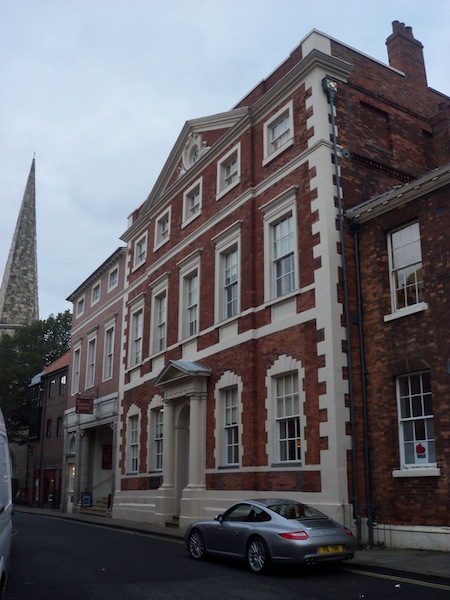|
Previous Entry
First Entry
|
Walking Tour of York
Second Stop, Fairfax House
As explained here, as part of my teaching
this year, I gave my students a walking tour of York. This is the second stop
on the tour. Caveat Lector - I do not vouch for the complete
accuracy of all of these bits and bobs. Do not quote me. Some of this
is myth and legend.
 Fairfax house was built in 1762 by Viscount Fairfax so he'd have someplace to
sleep during the winter season in York. He called upon John Carr, a
distinguished York architect to renovate and redesign the building, and
York craftsmen to furnish it. It passed through a number of hands
after the Viscount's death, but remained a private residence for a hundred
years or so. As with so many grand residences, it saw military use in WWI,
and then, after the war, became a theatre. Eventually, it fell out of use
and began to fall into disrepair. The York Civic Trust acquired it in 1982
and turned it into the museum it is today.
Fairfax house was built in 1762 by Viscount Fairfax so he'd have someplace to
sleep during the winter season in York. He called upon John Carr, a
distinguished York architect to renovate and redesign the building, and
York craftsmen to furnish it. It passed through a number of hands
after the Viscount's death, but remained a private residence for a hundred
years or so. As with so many grand residences, it saw military use in WWI,
and then, after the war, became a theatre. Eventually, it fell out of use
and began to fall into disrepair. The York Civic Trust acquired it in 1982
and turned it into the museum it is today.
It's a lovely Georgian townhouse, and I know very little about Georgian
townhouses, but I wanted to show that York also has history which is not
medieval.
From here, we passed through the Coppergate Centre on our way to our next stop.
The Coppergate Centre is a shopping mall, and is home to the Jorvik Viking
Centre. Underneath all that is the medieval street, Coppergate. Prior to
building the new center, extensive archaeological work was done on the site,
and a number of publications were generated by the York Archaeological Trust.
This was a good place to spend a few moments talking about the problems of
modern cities on historic sites, and some of the difficulties associated with
doing urban history. For example, I am aware of no extant medieval urban
kitchens. If the buildings exist, they've been remodeled. Often, though,
they were wholly or partially demolished for street-widening or other building
projects. A lot of stuff is still there, of course, just buried - like a King
in a car-park. And, just like a King in a car-park, we can't get to it without
a great deal of money, disruption, and the expenditure of political capital.
The corollary to the above, is that every time there is a building project,
there is the possibility that emergency archaeology will have to be done. When
I arrived in York, renovations were taking place at King's Square, and were
temporarily delayed because they'd found a medieval church. Developers are required both to plan for the eventuality of
such discoveries and shoulder a share of the economic burden. At the end
of the day, though, the city is a living organism and life must go on. All
that stuff is hidden away again, underneath the lovely new flagstones.
Luddite'sLog, 4 November 2014
© 2014 Jeff Berry
|
Next Entry
Last Entry
|
![Smashy the Hammer hates cell phones [Smashy the Hammer]](/hammer.gif)
![Of course there is mouseover text, because, hey, aspiring. [An Aspiring Luddite]](/Luddite2.gif)
![I am looking at my off-camera
bass guitar [Jeff Berry]](/file.jpg)
 Fairfax house was built in 1762 by Viscount Fairfax so he'd have someplace to
sleep during the winter season in York. He called upon John Carr, a
distinguished York architect to renovate and redesign the building, and
York craftsmen to furnish it. It passed through a number of hands
after the Viscount's death, but remained a private residence for a hundred
years or so. As with so many grand residences, it saw military use in WWI,
and then, after the war, became a theatre. Eventually, it fell out of use
and began to fall into disrepair. The York Civic Trust acquired it in 1982
and turned it into the museum it is today.
Fairfax house was built in 1762 by Viscount Fairfax so he'd have someplace to
sleep during the winter season in York. He called upon John Carr, a
distinguished York architect to renovate and redesign the building, and
York craftsmen to furnish it. It passed through a number of hands
after the Viscount's death, but remained a private residence for a hundred
years or so. As with so many grand residences, it saw military use in WWI,
and then, after the war, became a theatre. Eventually, it fell out of use
and began to fall into disrepair. The York Civic Trust acquired it in 1982
and turned it into the museum it is today.